You are here: Home - Inverter for solar systems - Orvaldi Solar OffGrid
series: Inverter for solar systems
ORVALDI Solar OffGrid
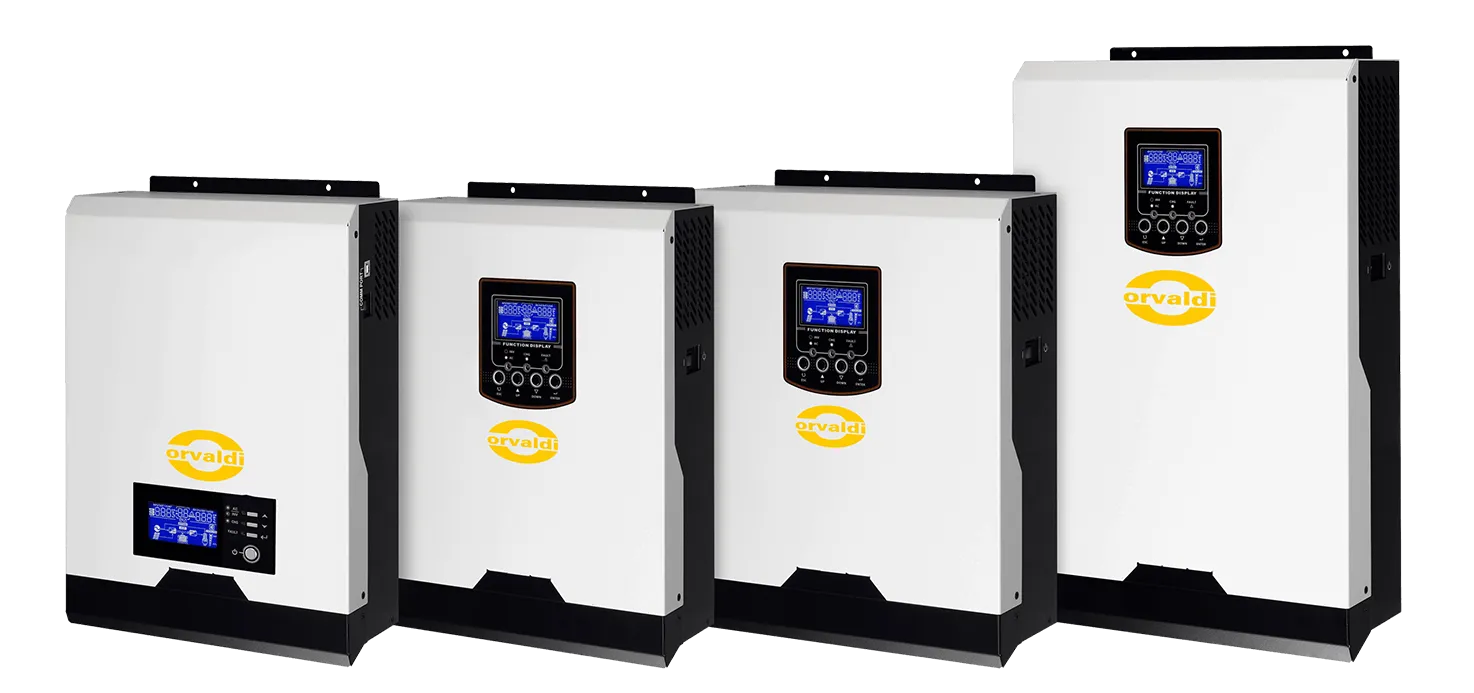_webp.webp)
Product Features:
- Pure Sine Wave Inverter – Provides clean and stable power, suitable for sensitive electronic devices.
- Versatile Battery Compatibility – Supports AGM, FLD (Flooded Lead-Acid), and User-Defined battery settings, allowing customization for various battery types.
- Intelligent LCD Display – Multifunctional LCD for real-time monitoring and easy configuration of operating modes, including input/output voltage, battery status, and charging parameters.
- Priority Source Configuration – Allows selection between Solar First, Utility First, Solar and Utility, and Only Solar modes, optimizing energy source use based on user preferences and environmental conditions.
- Integrated Solar Charger – Compatible with both PWM and MPPT solar chargers, ensuring efficient energy conversion from solar panels.
- Communication Ports (USB/RS-232) – Facilitates easy monitoring and control via computer connection, enhancing the user experience and system management.
List of Applications:
- Home Backup Power
- Small Business and Office Use
- Renewable Energy Systems
- Remote and Off-Grid Power
- Industrial Equipment Support
- RVs and Boats
- Emergency Power Supply
- Construction Site Power
- Telecommunications
- Agricultural Use
DOWNLOAD:
"HIGH QUALITY" OPTION:
ORVALDI will, in accordance with the terms and conditions of insurance, replace, repair or compensate ORVALDI products and/or connected devices in the event of damage as a result of an electrical surge. The maximum total amount compensated is 5000Euro (five thousand Euros).

PWM Controller
ORVALDI KS1K+ |
ORVALDI KS3K+ |
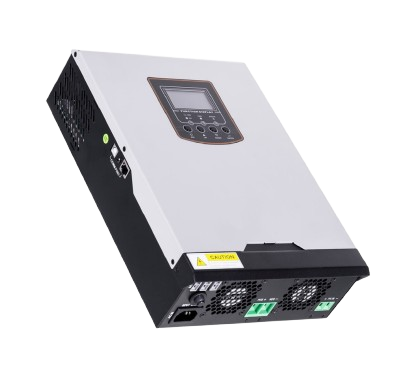 |
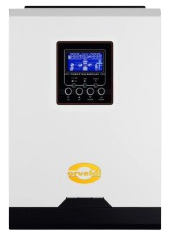 |
 |
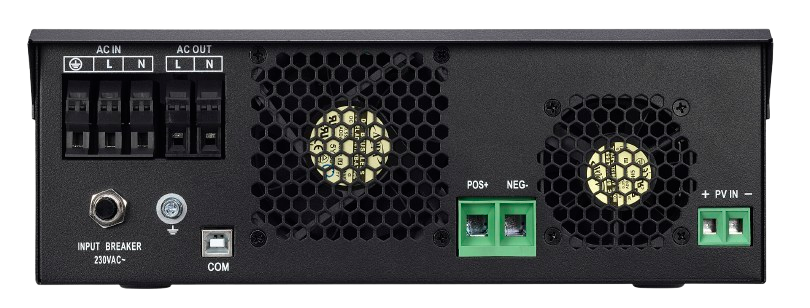 |
MPPT Controller
ORVALDI MKS5K easy |
ORVALDI MKS5K+ |
ORVALDI MVII5K |
 |
 |
 |
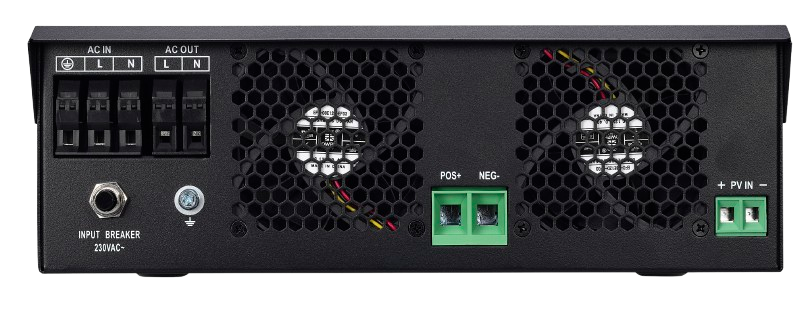 |
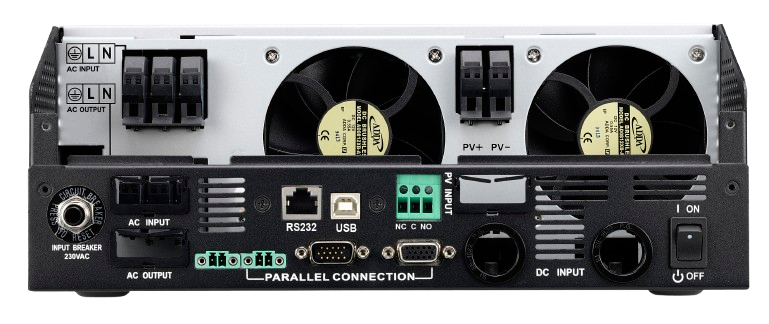 |
 |
|
|
|
|
Key Differences
The ORVALDI OFF-GRID SOLAR series offers a versatile range of models with varying power capacities, tailored to meet diverse energy needs. Each model comes equipped with different PV controllers, ensuring maximum efficiency in solar energy management. Whether you need a system with a PWM controller or a more advanced MPPT controller, ORVALDI has you covered, with PV controller power ratings that scale with the device's capacity. From compact 1000 VA systems with 600 W PV support to more robust 5000 VA units with up to 4000 W PV power, ORVALDI delivers the perfect solution for both small and large-scale applications.
| Model | Total Device Power | PV Power | PV Voltage | DC Battery Voltage |
| ORVALDI KS1K+ | 1000 VA 1000 W |
600 W | 15-18 VDC (PWM) |
12 VDC |
| ORVALDI KS3K+ | 3000 VA 3000 W |
1800 W | 30-32 VDC (PWM) |
24 VDC |
| ORVALDI MKS5K easy | 5000 VA 5000 W |
3000 W | 60-115 VDC (MPPT) |
48 VDC |
| ORVALDI MKS5K+ | 5000 VA 5000 W |
4000 W | 60-115 VDC (MPPT) |
48 VDC |
| ORVALDI MVII5K | 5000 VA 5000 W |
4000 W | 120-450 VDC (MPPT) |
48 VDC |
Parallel Operation Capability* (only ORVALDI MKS5K+)
.png)
Single-Phase Parallel System
In a single-phase configuration, up to four inverters can be connected in parallel. This setup increases the total output power, making it an ideal solution when higher power is required to support multiple devices. It’s a perfect option for users who need a scalable system that can grow with their increasing energy demands.
Three-Phase System
ORVALDI inverters can also be configured to operate in a three-phase system, enabling the power supply to different loads across each phase. Additionally, you can assign a different number of inverters to each phase—for example, three inverters on L1, two on L2, and one on L3. This configuration allows for optimal power distribution and customizes the system to meet specific energy needs on each phase.
Benefits of a Three-Phase System with Variable Power Distribution
The ability to flexibly distribute power across different phases is a significant advantage. It allows you to match the power supply to the actual load requirements in a given environment, avoiding issues with unbalanced phase loads. This flexibility maximizes the use of available energy resources and ensures system stability, even with varying power demands across phases.
Charger and Output Source Priorities
Choosing the right charging and output source priority in ORVALDI inverters allows users to optimize energy efficiency, cost savings, and reliability based on their specific needs. Each mode offers distinct advantages, catering to different preferences and system setups.
Solar First Priority (SBU)
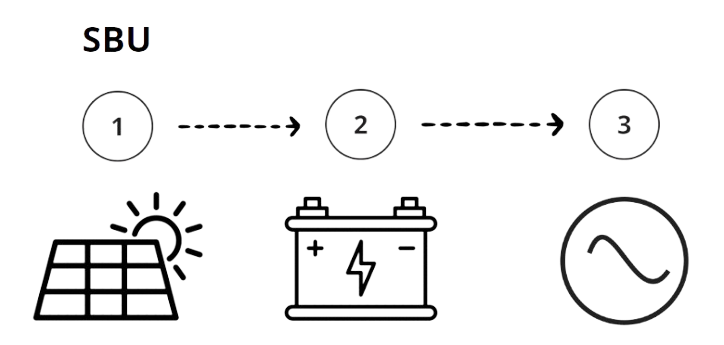
- How it works: This mode prioritizes charging the batteries from solar panels. The grid is only used when solar energy is insufficient, ensuring that renewable energy is maximized.
- Advantages: Ideal for maximizing savings and sustainability, it reduces reliance on traditional energy sources and lowers electricity bills. It's an excellent way to minimize your carbon footprint.
- Who is it for?: Perfect for individuals and businesses with well-established solar systems who want to fully harness solar power and prioritize renewable energy.
Utility First Priority (USB)
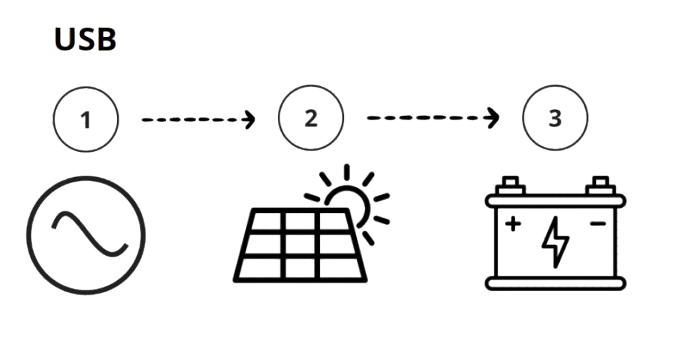
- How it works: In this mode, the grid is the primary source for charging the batteries. Solar power is secondary, ensuring that your system remains reliable, even in less favorable weather.
- Advantages: Ensures continuous power by prioritizing grid electricity when solar energy is limited. This guarantees stable power supply and uninterrupted operation.
- Who is it for?: Best for users in areas with less access to solar energy or for those who prioritize reliability and need stable, 24/7 power.
Solar and Utility (SUB)
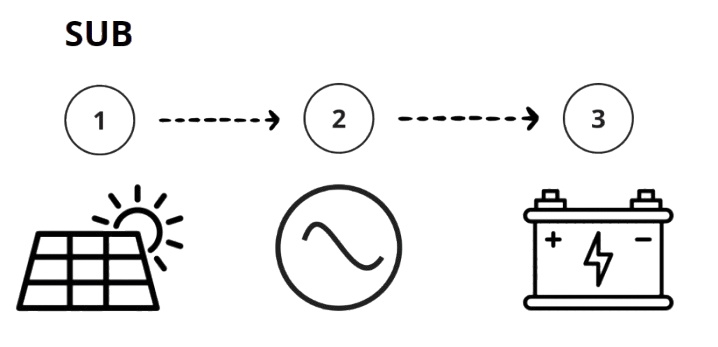
- How it works: This balanced approach charges the batteries using both solar energy and the grid simultaneously. This dual-source charging ensures faster battery recharge and energy efficiency.
- Advantages: The combination of solar and grid energy provides the flexibility to optimize charging speed and energy use, enhancing both reliability and cost-effectiveness.
- Who is it for?: Suitable for those who seek the fastest battery charging times while still benefiting from renewable energy savings.
Only Solar

- How it works: This mode relies solely on solar energy for charging the batteries, with minimal grid involvement.
- Advantages: By fully utilizing solar energy, users can achieve energy autonomy and significantly reduce their dependency on the grid, leading to lower energy costs.
- Who is it for?: Ideal for users who aim for complete energy independence and are committed to reducing grid usage as much as possible.
Battery Type
Battery Type: Tailored to Your Needs
- AGM (Default): This battery type is ideal for users seeking a maintenance-free, robust solution with a long lifespan. AGM batteries offer high efficiency at low maintenance costs.
- FLD (Flooded Lead-Acid): FLD batteries are traditional lead-acid batteries with liquid electrolyte. They are characterized by lower upfront costs and are widely used in various applications. This is a great option for those who need a proven and cost-effective solution but are willing to perform regular maintenance, such as topping up with distilled water.
- User-Defined: For more advanced users who want full control over their system, the user-defined option allows precise adjustment of charging voltage and DC cutoff thresholds. This option is ideal for custom settings for specialized battery types, such as lithium-ion.
TECHNICAL DATA:
| Specification | ORVALDI KS1K+ | ORVALDI KS3K+ | ORVALDI MKS5K easy | ORVALDI MKS5K+ | ORVALDI MVII5K |
| Network Mode Specifications | |||||
| Input Signal Shape | Sine Wave | Sine Wave (grid or generator) | Sine Wave | ||
| Nominal Input Voltage | 230Vac | ||||
| Input Voltage Level for Battery Mode (Low/High)* | <170Vac±7V | <170Vac±7V (UPS) / ≧280Vac±7V | <170Vac±7V (UPS) / ≧280Vac±7V | <170Vac±7V (UPS) | |
| Voltage Level for Return to Grid Mode (Low/High)* | ≧180Vac±7V | ≧180Vac±7V (UPS) / <270Vac±7V | ≧180Vac±7V (UPS) / <270Vac±7V | ≧180Vac±7V (UPS) | |
| Max Input Voltage | 300V AC | ||||
| Nominal Input Frequency | 50Hz / 60Hz (Auto) | ||||
| Frequency Level for Battery Mode (Low/High)* | <40±1Hz | <40±1Hz / ≧65±1Hz | <40±1Hz / ≧65±1Hz | ≧280Vac±7V | |
| Frequency Level for Return to Grid Mode (Low/High)* | ≧42±1Hz | ≧42±1Hz / <63±1Hz | ≧42±1Hz / <63±1Hz | <270Vac±7V | |
| Short-circuit Protection | Fuse | ||||
| Efficiency | >95% (resistive load, fully charged batteries) | ||||
| Switching Time | 10ms typical | ||||
| Battery Mode Specifications | |||||
| Output Power | 1KVA/1KW | 3KVA/3KW | 5KVA/5KW | ||
| Output Voltage Shape | Pure Sine Wave | ||||
| Output Voltage Value | 230Vac±5% | ||||
| Output Frequency | 50Hz | ||||
| Efficiency in Battery Mode | 90% | 93% | |||
| Overload Protection | 5s ≥150% Pmax; 10s 110%~150% Pmax | ||||
| DC Circuit Voltage | 12Vdc | 24Vdc | 48Vdc | ||
| Minimum DC Voltage for Cold Start | 11.5Vdc | 23.0Vdc | 46.0Vdc | ||
| Low Battery Voltage (Load < 20%) | 11.0Vdc | 22.0Vdc | 44.0Vdc | ||
| Low Battery Voltage (20% ≤ Load < 50%) | 10.7Vdc | 21.4Vdc | 42.8Vdc | ||
| Low Battery Voltage (Load ≥ 50%) | 10.1Vdc | 20.2Vdc | 40.4Vdc | ||
| Low Voltage Alarm (Load < 20%) | 11.5Vdc | 23.0Vdc | 46.0Vdc | ||
| Low Voltage Alarm (20% ≤ Load < 50%) | 11.2Vdc | 22.4Vdc | 44.8Vdc | ||
| Low Voltage Alarm (Load ≥ 50%) | 10.6Vdc | 21.2Vdc | 42.4Vdc | ||
| Cut-off Voltage (Load < 20%) | 10.5Vdc | 21.0Vdc | 42.0Vdc | ||
| Cut-off Voltage (20% ≤ Load < 50%) | 10.2Vdc | 20.4Vdc | 40.8Vdc | ||
| Cut-off Voltage (Load ≥ 50%) | 9.6Vdc | 19.2Vdc | 38.4Vdc | ||
| High Battery Voltage Alarm | 14Vdc | 29Vdc | 58Vdc | ||
| Upper Charger Cut-off Voltage | 16Vdc | 33Vdc | 60Vdc | ||
| Power Consumption (Self Use) | <15W | <20W | <20W | ||
| Power Consumption (Energy-saving Mode) | <5W | <10W | <10W | ||
| Charger Specifications | |||||
| Charging Algorithm | 3-stage | ||||
| Max Charging Current (Grid Mode) | 10/20A | 10/25A (VI/P=230Vac) | 20/30A (VI/P=230Vac) | ||
| Float Charging Voltage | 13.5Vdc | 27Vdc | 54Vdc | ||
| Max Charging Current (Solar Mode) | 50A | 60A (3kW) | |||
| DC Circuit Voltage (Solar) | 12Vdc | 24Vdc | 48Vdc | ||
| Max Solar Panel Voltage | 55Vdc | 80Vdc | 145Vdc | 500Vdc | |
| Power Consumption (Standby Mode) | 1W | 2W | |||
* Dotyczy MKS5K easy oraz MKS5K+

